 |
New York
Architecture Images-Upper East Side Whitney Museum Of American Art |
|
|
architect |
Marcel Breuer | |
|
location |
945 Madison Ave., At East 75th. | |
|
date |
1966 | |
|
style |
Brutalism | |
|
construction |
Off-form concrete | |
|
type |
Museum,Gallery | |
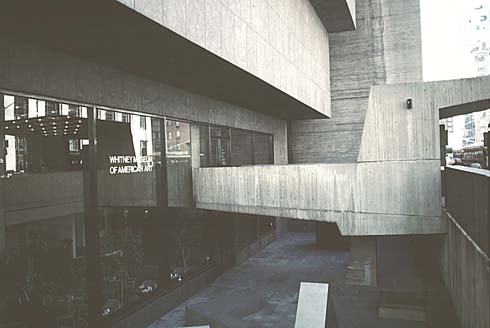 |
||
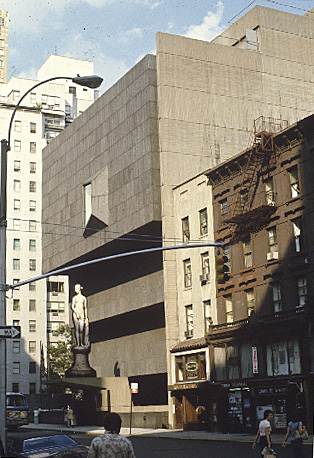 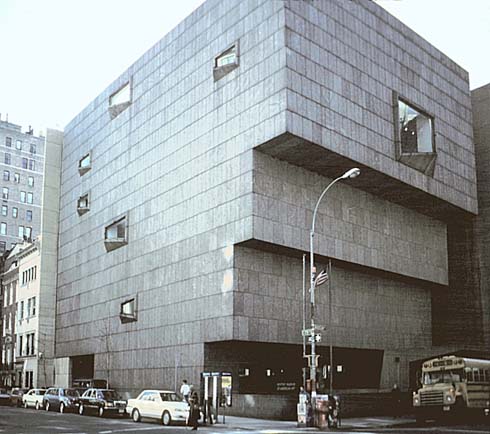 |
||
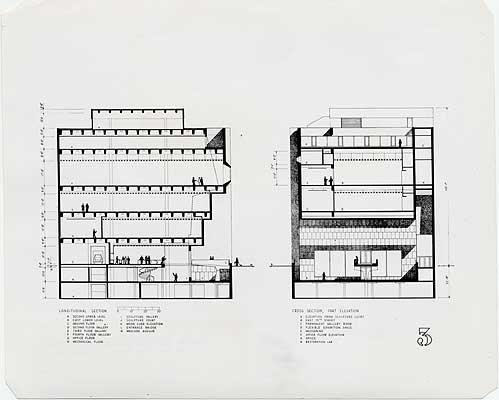 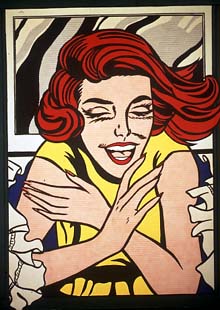 |
||
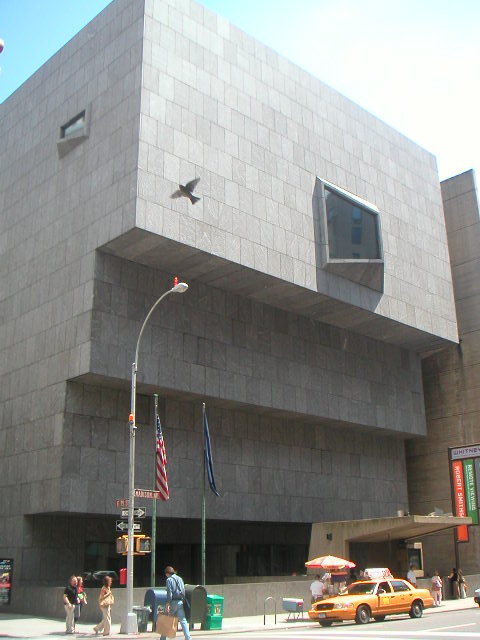 |
||
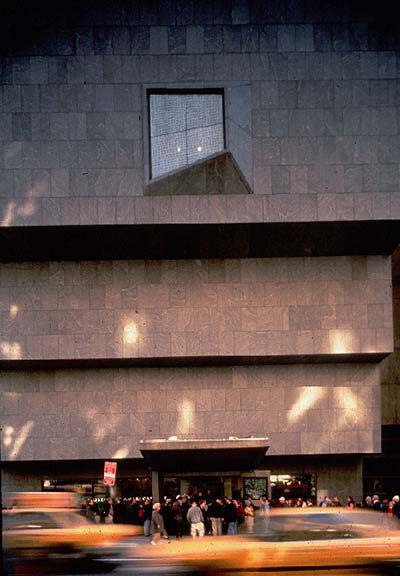 |
||
|
History of
the Whitney The Whitney Museum houses one of the world's foremost collections of twentieth-century American art. The Permanent Collection of some 12,000 works encompasses paintings, sculptures, multimedia installations, drawings, prints, and photographs—and is still growing. The Museum was founded in 1931 with a core group of 700 art objects, many of them from the personal collection of founder Gertrude Vanderbilt Whitney; others were purchased by Mrs. Whitney at the time of the opening to provide a more thorough overview of American art in the early decades of the century. Mrs. Whitney favored the art of the revolutionary artists derisively called the Ashcan School, among them John Sloan, George Luks, and Everett Shinn, as well as realists such as Edward Hopper and American Scene painters John Steuart Curry and Thomas Hart Benton. Her initial gift, however, also comprised many important works by early modernists—Stuart Davis, Charles Demuth, Charles Sheeler, Max Weber, and others. Virtually all the works collected by the Museum for the next twenty years came through the generosity of Mrs. Whitney. Although the Whitney's acquisition budget was always rather modest, the Museum made the most of its resources by purchasing the work of living artists, particularly those who were young and not well known. It has been a long-standing tradition of the Whitney to purchase works from the Museum's Annual and Biennial exhibitions, which began in 1932 as a showcase for recent American art. A number of the Whitney's masterpieces came from these exhibitions, including works by Arshile Gorky, Stuart Davis, Reginald Marsh, Philip Guston, and Jasper Johns. Even today, the Museum continues to enrich its Permanent Collection via the Biennial; among the recent acquisitions are works by Mike Kelley, Matthew Barney, Louise Bourgeois, Zoe Leonard, Matthew Ritchie, and Shahzia Sikander. Following Mrs. Whitney's death in 1942, and the death of the Museum's first director, Juliana Force, in 1948, it became evident that to keep pace with the burgeoning artistic activity in the United States, the Whitney needed to substantially augment its acquisition funds. In 1956, a group of supporters formed the Friends of the Whitney Museum of American Art. This organization was led by ardent collectors and benefactors of American art: Seymour H. Knox, Mrs. Albert List, Milton Lowenthal, Roy R. Neuberger, Duncan Phillips, Nelson A. Rockefeller, David M. Solinger, and Hudson D. Walker. The Friends were responsible for acquiring some of the most spectacular paintings and sculptures represented in the collection. Without works such as Edward Hopper's Second Story Sunlight, David Smith's Lectern Sentinel, Franz Kline's Mahoning, Willem de Kooning's Door to the River, and Stuart Davis' The Paris Bit, as well as more than a hundred others purchased by the Friends, the Whitney's collection would be far less significant today, particularly in the field of abstract art. In addition to Mrs. Whitney's donations, the Museum's holdings have been greatly enriched through the generous gifts of other major collectors. Each of these contributions has indelibly marked the Whitney's overall collection with a distinctive, personal character. Among the most important of these collectors were Howard and Jean Lipman. Beginning in the 1960s, they donated an extraordinary selection of more than one hundred sculptures, creating one of the strongest museum collections of post-World War II American sculpture. Among the Lipmans' gifts was a large group of works by Alexander Calder and Lucas Samaras, as well as masterpieces by Donald Judd, Dan Flavin, Claes Oldenburg, Louise Nevelson, and George Segal. In 1987, the Museum received more than sixty works, primarily post-1945 painting, from the Lawrence H. Bloedel Bequest. These include highly significant canvases by Milton Avery, William Baziotes, Georgia O'Keeffe, and Fairfield Porter. Most recently, the Museum's late trustee Charles H. Simon left the Museum seventy-five pieces, including seventeen paintings and watercolors by John Marin. Now, thanks to Simon, the Whitney collection encompasses the full range of Marin's achievement, in both oils and watercolors, from the turn of the century until the artist's death in 1953. As young artists, Edward Hopper and Reginald Marsh began showing their work in the 1920s at the Whitney Studio Club, the Museum's precursor, and both continued to exhibit at the Museum. In appreciation of the Whitney's enduring support of their art, Josephine Nivison Hopper and Felicia Marsh, the artists' widows, made substantial bequests of their husbands' works to the Museum. Today, the Whitney holds the world's largest collection of Hopper's art—more than 2,500 oils and works on paper. The Museum's Marsh collection is unparalleled—nearly 200 works in all media, among them a number of the artist's best-known paintings, such as Why Not Use the "L"? and Twenty Cent Movie. Despite its early emphasis on realist art, the Whitney Museum has long been dedicated to assembling a collection that offers a comprehensive picture of twentieth-century American art. Although the collection is characterized by its breadth, it is equally recognized for its in-depth commitment to the work of a number of artists. In addition to the Hopper and Marsh collections, the Whitney has the largest body of work by Alexander Calder in any museum, ranging from the ever-popular Calder's Circus and Surrealist-inspired pieces of the 1940s to large-scale mobiles and stabiles. Other in-depth concentrations include major holdings by Marsden Hartley, Georgia O'Keeffe, Charles Burchfield, Gaston Lachaise, Louise Nevelson, and Agnes Martin. Text adapted from Adam D. Weinberg's introduction to American Art of the Twentieth Century: Treasures of the Whitney Museum of American Art. |
||
|
The Breuer
Building The Whitney Museum of American Art owes its striking granite presence at the southeast corner of Madison Avenue and 75th Street to the Hungarian-born, Bauhaus-trained architect Marcel Breuer (1902-1981). To design a third home for the Museum—which had gradually migrated northward from its original location on West 8th Street to West 54th Street—Breuer worked with Hamilton Smith, creating a strong modernist statement in a neighborhood of traditional limestone, brownstone, and brick row houses and postwar apartment buildings. Considered somber, heavy, and even brutal at the time of its completion in 1966 ("an inverted Babylonian ziggurat," according to one critic), Breuer's building is now recognized as daring, strong, and innovative. It has won landmark status, and has come to be identified with the Whitney's own uninhibited approach to twentieth-century art.
Permanent
Collection |
||
|
From the Marcel Breuer papers are photographs of Jacqueline Kennedy and architect Marcel Breuer touring the construction site for the Whitney Museum of American Art on October 21, 1965. The museum opened the following year. It was designed by Marcel Breuer and Hamilton Smith, architects, and Michael H. Irving, consulting architect, 1963-1966.
|
||
|
"For its third building in 35 years, the Whitney Museum chose a 100 x 125 foot site in the art gallery district of mid-town Madison Avenue where, among an environment of tall apartment buildings, a new, distinctive, and significant home was to be located. The housing of changing exhibitions rather than a permanent collection has determined the new museum's philosophy, planning, and details. Three of its floors have large, open gallery spaces with suspended precast concrete open grid ceilings, detailied to receive movable wall panels and flexible lighting that can be rearranged for each new show. Outside, the cube-like building is sheathed with granite." —Tician Papachristou. Marcel Breuer: New Buildings and Projects. p122. "This distinctive museum makes the most of its small corner site. Upper floors, affording maximum gallery space within, cantilever outward, importantly over its shadowy forecourt; seven windows—irregularly spaced trapezoids that vary in size—mark its granite facade like symbolic eyes." —from Sylvia Hart Wright. Sourcebook of Contemporary North American Architecture: From Postwar to Postmodern. p15-16. The Creator's Words "What should a museum look like, a museum in Manhattan? Surely it should work, it should fulfill its requirements, but what is its relationship to the New York landscape? What does it express, what is its architectural message? "It is easier to say first what it should not look like. It should not look like a business or office building, nor should it look like a place of light entertainment. Its form and its material should have identity and weight in the neighborhood of 50-story skyscrapers, of mile long bridges, in the midst of the dynamic jungle of our colorful city. It should be an independent and self- relying unit, exposed to history, and at the same time it should transform the vitality of the street into the sincerity and profundity of art." —Marcel Breuer. from Tician Papachristou. Marcel Breuer: New Buildings and Projects. p14-15. Address Whitney Museum of American Art |
||
|
links |
http://www.whitney.org/index.shtml | |